Neurobiology of Trauma
and Treatment |
James Kowal, M.S., LCPC
Center for Traumatic Stress Naperville,
IL (630) 637-4002 |
Based on the author’s
slide and lecture seminars, this presentation
was specially compiled for Energy Psychology
Interactive. |
| © Copyright 2002, James A.
Kowal, All rights reserved. |
|
|
|
|
|
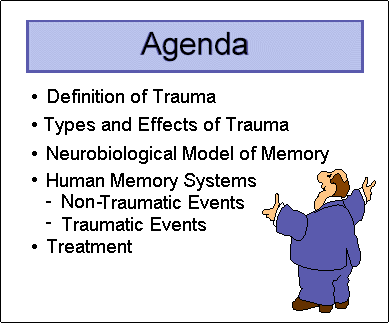 |
 |
I will begin
by defining trauma based on the Diagnostic
and Statistical Manual of Mental Disorders, (4th Edition, Text Revision, APA, 2000) |
and discussing the types
of trauma and the relationship of various factors to the effects of trauma. |
|
|
|
|
I will then describe the neurological effects of trauma on the human nervous system. A
neurobiological model of memory will show how non-traumatic vs. traumatic events are
stored in memory. Finally, I will discuss some treatment considerations in dealing with
victims of trauma.
|
|
Trauma is experienced when one is exposed to an
uncontrollable, terrifying life event in which the person perceives immediate threat to
his or her health, safety, or life (van der Kolk, 1987). How one responds to the
experience depends on the nature of the trauma, the age of the victim, predisposing
personality traits, and the community’s response to the trauma. We are also learning
that the type of attachment one forms during the first two years of life may establish
vulnerability to post-traumatic stress reactions. |
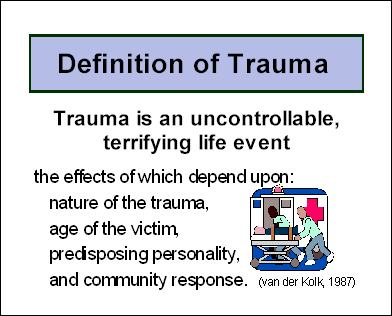
|
|
|
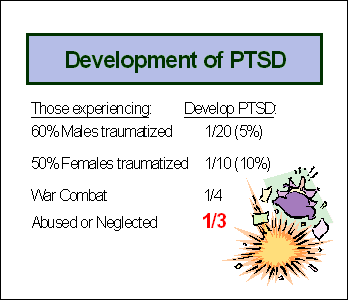 |
Not
everyone who is exposed to a life threatening event develops posttraumatic stress disorder
(PTSD). Sixty percent of males experience some type of trauma during their life, but only
five percent will develop PTSD. A slightly lower proportion of females, about 50%, will
experience a major trauma during their lifetime. Ten percent of them, twice the rate of
males, will develop PTSD. Of individuals who have experienced combat in a war situation,
one out of four will develop PTSD. Of individuals who have been physically/sexually abused
or neglected, one out of three will develop PTSD. |
|
|
| Criteria for the DSM-IV-TR (APA, 2000)
definition of trauma can be remembered as follows: |
|
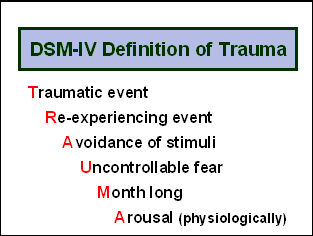 |
|
| "T"
|
one has to have experienced a
traumatic
event. |
| "R" |
one keeps
re-experiencing the
event through obsessive thoughts, nightmares, night terrors, or flashbacks. |
| "A" |
one finds that he/she
avoids
certain persons, places, things, or situations, because of the anxiety that he/she
experiences when confronted with the stimulus. |
| "U" |
one experiences
uncontrollable, irrational fear when confronted by the stimulus.
|
| "M" |
a
month is an important
element in the assessment of trauma, as I will explain on the next slide. |
| "A" |
the person experiences
physiological arousal, such as, increased heart rate, shortness of breath, perspiration,
etc. Others report having symptoms of a "panic attack." |
|
|
|
A month is
an important marker. If the person is experiencing the symptoms described on the previous
slide and the traumatic event occurred within the past month, the diagnosis is Acute Stress Disorder.
If the person is experiencing these symptoms and the traumatic event occurred more than
one month earlier, the diagnosis is Post-Traumatic Stress
Disorder (PTSD). |
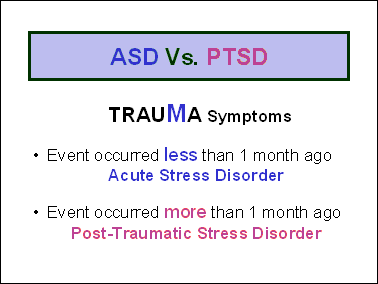
|
|
|
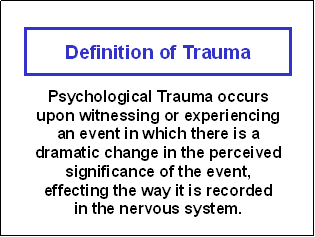 |
Another
definition of psychological trauma, shown on the slide, is based on the neurobiological
effects believed to occur upon witnessing or experiencing a traumatic event. To understand
this definition, we need to look at what happens in the nervous system when we experience
both normal and abnormal events. |
|
|
2. TYPES AND EFFECTS OF TRAUMA >> |
|
 |
 |
|
 |
 |
|
|